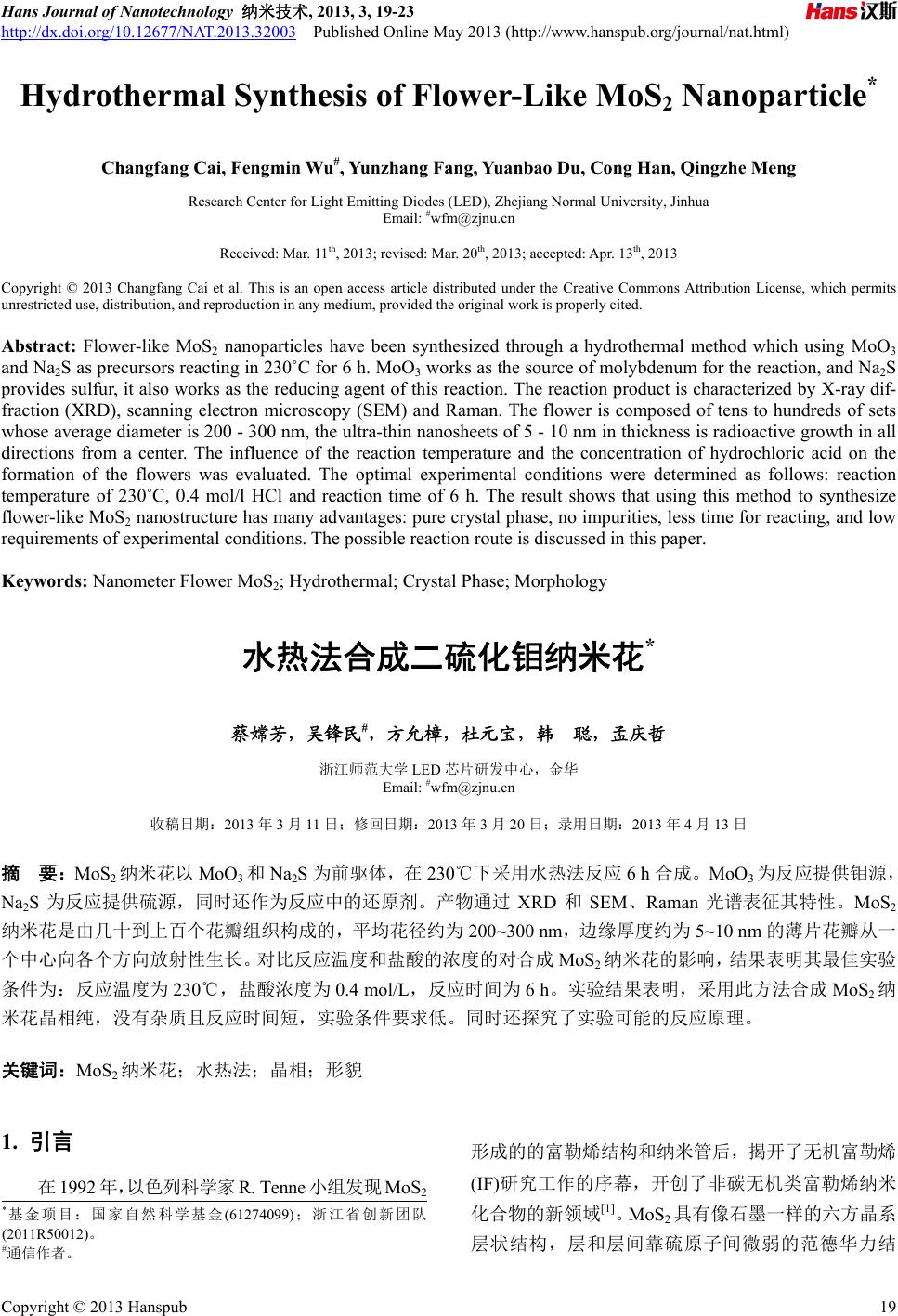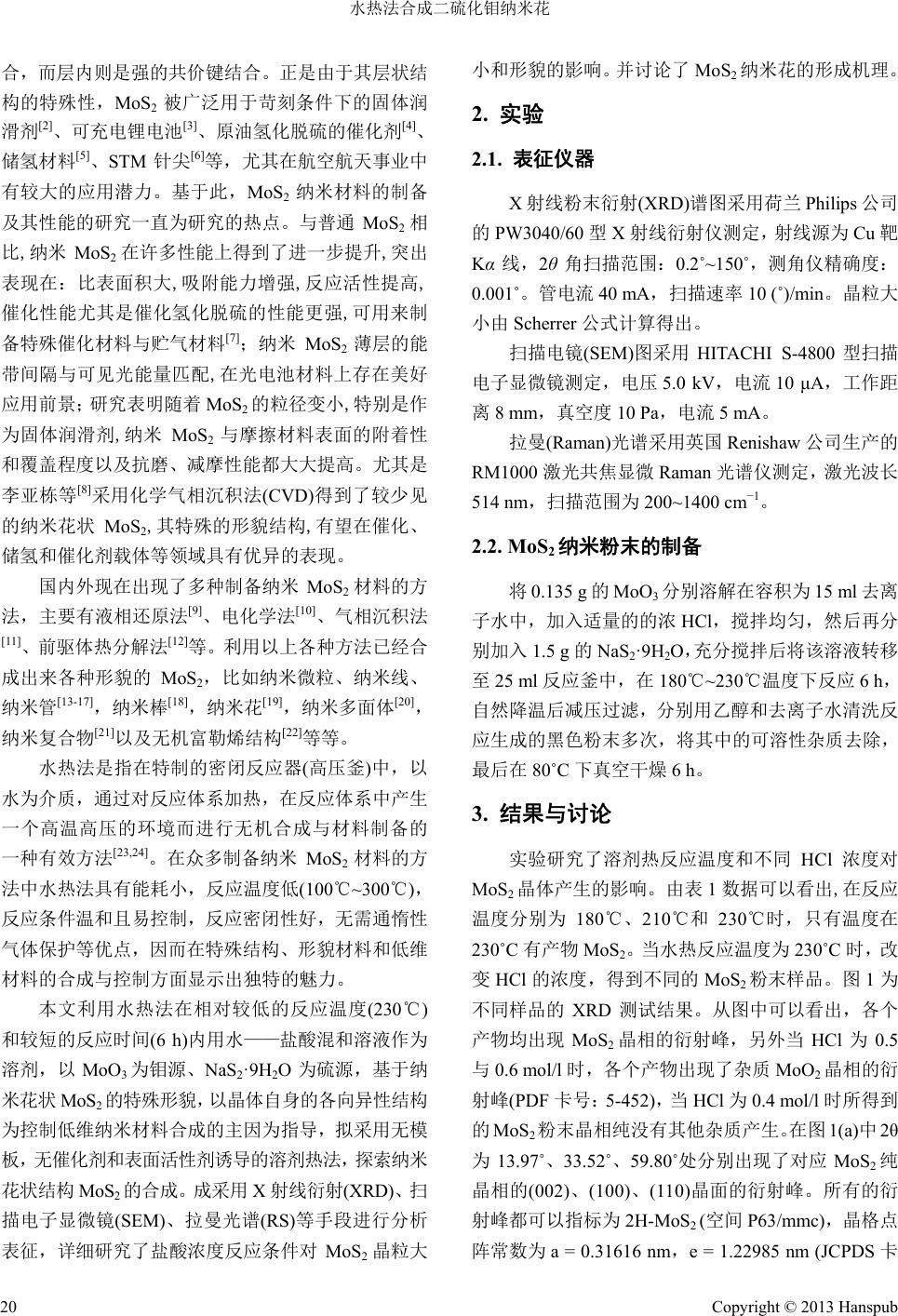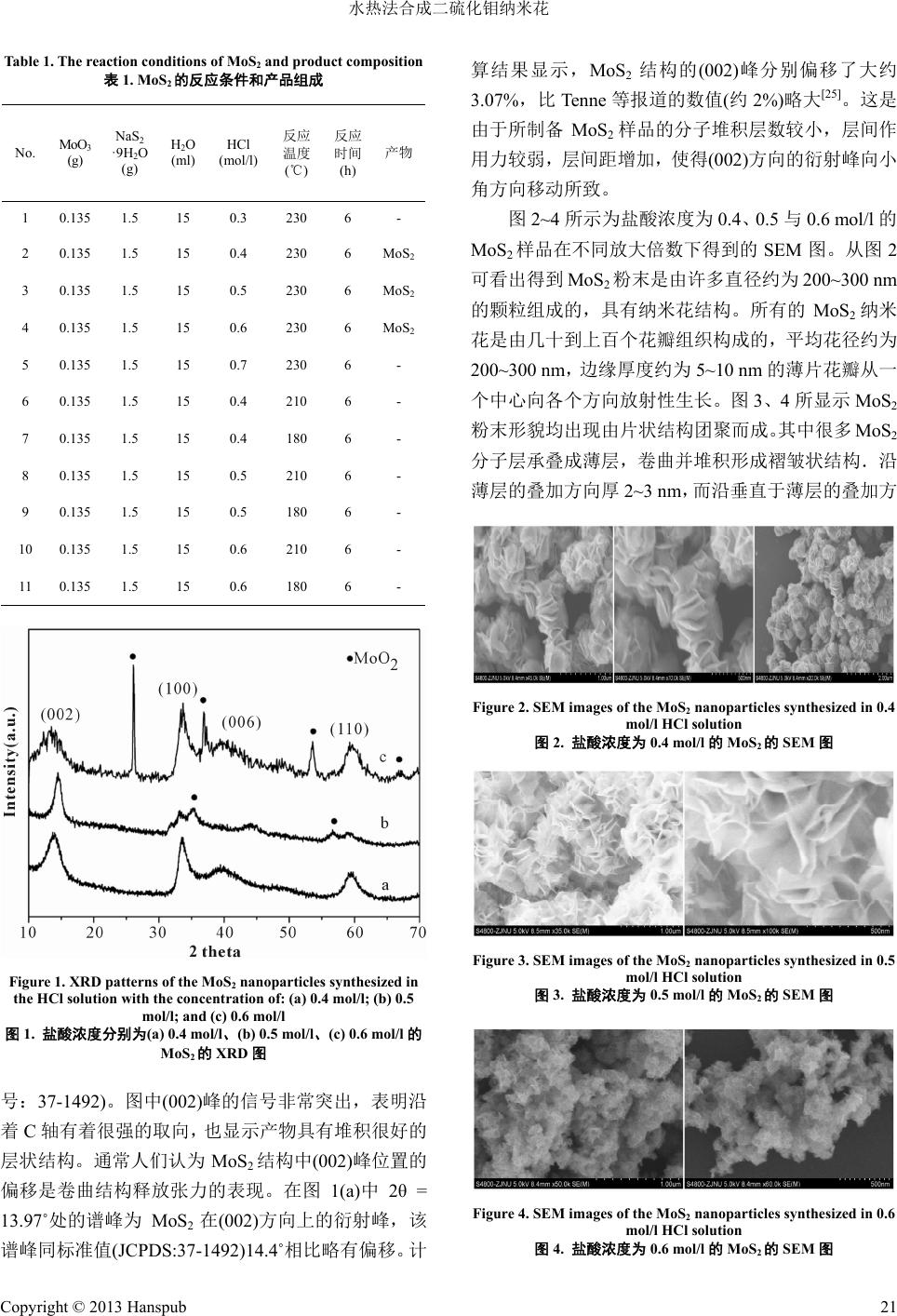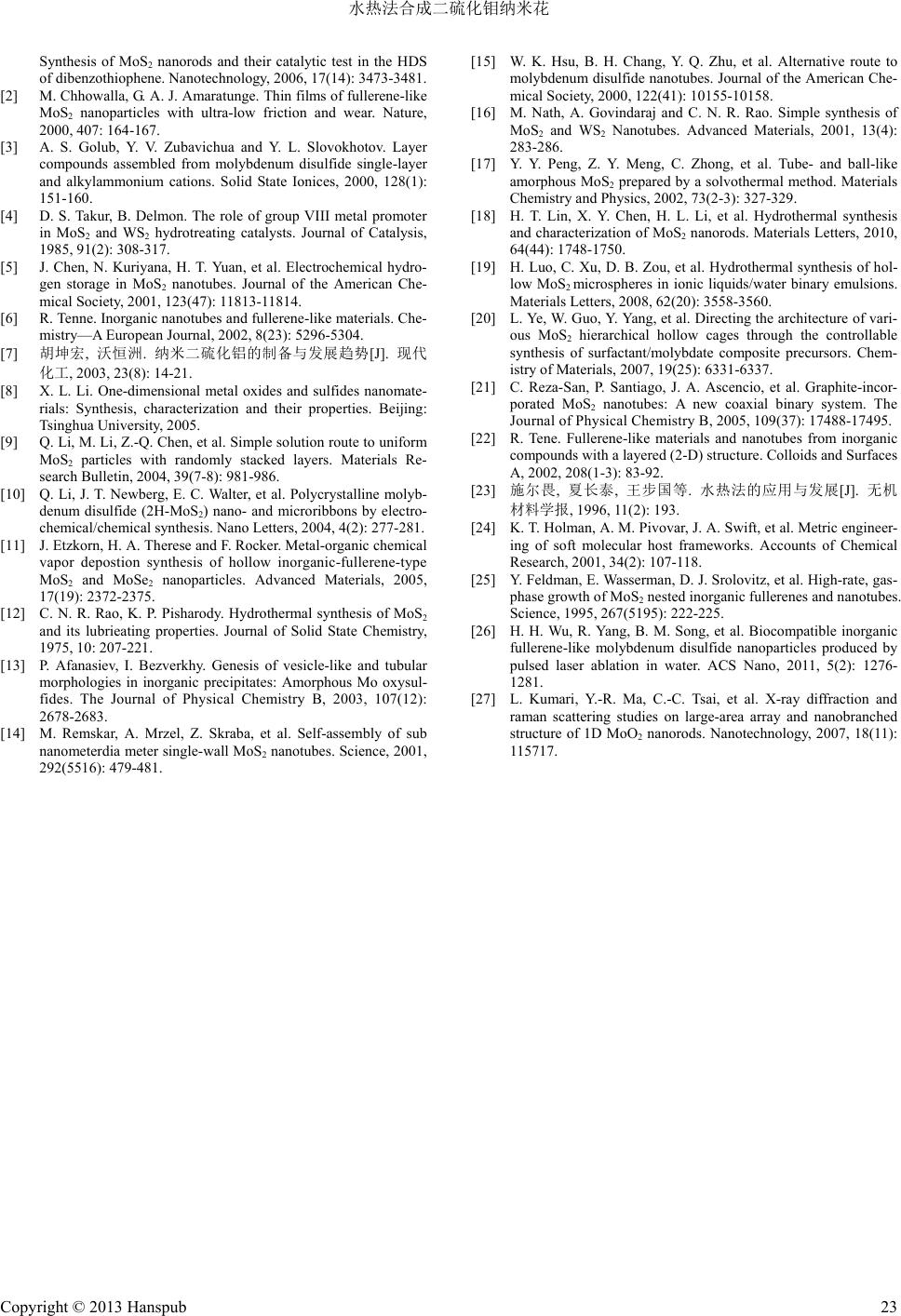 Hans Journal of Nanotechnology 纳米技术, 2013, 3, 19-23 http://dx.doi.org/10.12677/NAT.2013.32003 Published Online May 2013 (http://www.hanspub.org/journal/nat.html) Hydrothermal Synthesis of Flower-Like MoS2 Nanoparticle* Changfan g C ai , Fe ngmi n Wu#, Yun zhang Fang, Yuanbao Du, Cong Han, Qingzhe Meng Research Center for Light Emitting Diodes (LED), Zhejiang Normal University, Jinhua Email: #wfm@zjnu.cn Received: Mar. 11th, 2013; revised: Mar. 20th, 2013; accepted: Apr. 13th, 2013 Copyright © 2013 Changfang Cai et al. This is an open access article distributed under the Creative Commons Attribution License, which permits unrestricted use, distribution, and reproduction in any medium, provided the original work is properly cited. Abstract: Flower-like MoS2 nanoparticles have been synthesized through a hydrothermal method which using MoO3 and Na2S as precursors reacting in 230˚C for 6 h. MoO3 works as the source of molybdenum for the reaction, and Na2S provides sulfur, it also works as the reducing agent of this reaction. The reaction product is characterized by X-ray dif- fraction (XRD), scanning electron microscopy (SEM) and Raman. The flower is composed of tens to hundreds of sets whose average diameter is 200 - 300 nm, the ultra-thin nanosheets of 5 - 10 nm in thickness is radioactive growth in all directions from a center. The influence of the reaction temperature and the concentration of hydrochloric acid on the formation of the flowers was evaluated. The optimal experimental conditions were determined as follows: reaction temperature of 230˚C, 0.4 mol/l HCl and reaction time of 6 h. The result shows that using this method to synthesize flower-like MoS2 nanostructure has many advantages: pure crystal phase, no impurities, less time for reacting, and low requirements of experimental conditions. The possible reaction route is discussed in this paper. Keywords: Nanometer Flower MoS2; Hydrothermal; Crystal Phase; Morphology 水热法合成二硫化钼纳米花* 蔡嫦芳,吴锋民#,方允樟,杜元宝,韩 聪,孟庆哲 浙江师范大学 LED 芯片研发中心,金华 Email: #wfm@zjnu.cn 收稿日期:2013 年3月11 日;修回日期:2013年3月20日;录用日期:2013 年4月13 日 摘 要:MoS2纳米花以 MoO3和Na2S为前驱体,在 230℃下采用水热法反应 6 h 合成。MoO3为反应提供钼源, Na2S为反应提供硫源,同时还作为反应中的还原剂。产物通过 XRD 和SEM、Raman 光谱表征其特性。MoS2 纳米花是由几十到上百个花瓣组织构成的,平均花径约为 200~300 nm,边缘厚度约为 5~10 nm的薄片花瓣从一 个中心向各个方向放射性生长。对比反应温度和盐酸的浓度的对合成 MoS2纳米花的影响,结果表明其最佳实验 条件为:反应温度为23 0℃,盐酸浓度为 0.4 mol/L,反应时间为6 h。实验结果表明,采用此方法合成Mo S2纳 米花晶相纯,没有杂质且反应时间短,实验条件要求低。同时还探究了实验可能的反应原理。 关键词:MoS2纳米花;水热法;晶相;形貌 1. 引言 在1992 年,以色列科学家 R. Tenne小组发现 MoS2 形成的的富勒烯结构和纳米管后,揭开了无机富勒烯 (IF)研究工作的序幕,开创了非碳无机类富勒烯纳米 化合物的新领域[1]。MoS2具有像石墨一样的六方晶系 层状结构,层和层间靠硫原子间微弱的范德华力结 *基金项目:国家自然科学基金(61274099);浙江省创新团队 (2011R50012)。 #通信作者。 Copyright © 2013 Hanspub 19  水热法合成二硫化钼纳米花 合,而层内则是强的共价键结合。正是由于其层状结 构的特殊性,MoS2被广泛用于苛刻条件下的固体润 滑剂[2]、可充电锂电池[3]、原油氢化脱硫的催化剂[4]、 储氢材料[5]、STM 针尖[6]等,尤其在航空航天事业中 有较大的应用潜力。基于此,MoS2纳米材料的制备 及其性能的研究一直为研究的热点。与普通 MoS2相 比,纳米 MoS2在许多性能上得到了进一步提升,突出 表现在:比表面积大,吸附能力增强,反应活性提高, 催化性能尤其是催化氢化脱硫的性能更强,可用来制 备特殊催化材料与贮气材料[7];纳米 MoS2薄层的能 带间隔与可见光能量匹配,在光电池材料上存在美好 应用前景;研究表明随着 MoS2的粒径变小,特别是作 为固体润滑剂,纳米 MoS2与摩擦材料表面的附着性 和覆盖程度以及抗磨、减摩性能都大大提高。尤其是 李亚栋等[8]采用化学气相沉积法(CVD)得到了较少见 的纳米花状 MoS2,其特殊的形貌结构,有望在催化、 储氢和催化剂载体等领域具有优异的表现。 国内外现在出现了多种制备纳米 MoS2材料的方 法,主要有液相还原法[9]、电化学法[10]、气相沉积法 [11]、前驱体热分解法[12]等。利用以上各种方法已经合 成出来各种形貌的 MoS2,比如纳米微粒、纳米线、 纳米管[13-17],纳米棒[18],纳米花[19],纳米多面体[20], 纳米复合物[21]以及无机富勒烯结构[22]等等。 水热法是指在特制的密闭反应器(高压釜)中,以 水为介质,通过对反应体系加热,在反应体系中产生 一个高温高压的环境而进行无机合成与材料制备的 一种有效方法[23,24]。在众多制备纳米 MoS2材料的方 法中水热法具有能耗小,反应温度低(100℃~300℃), 反应条件温和且易控制,反应密闭性好,无需通惰性 气体保护等优点,因而在特殊结构、形貌材料和低维 材料的合成与控制方面显示出独特的魅力。 本文利用水热法在相对较低的反应温度(230℃) 和较短的反应时间(6 h)内用水——盐酸混和溶液作为 溶剂,以 MoO3为钼源、NaS2·9H2O为硫源,基于纳 米花状 MoS2的特殊形貌,以晶体自身的各向异性结构 为控制低维纳米材料合成的主因为指导,拟采用无模 板,无催化剂和表面活性剂诱导的溶剂热法,探索纳米 花状结构 MoS2的合成。成采用 X射线衍射(XRD)、扫 描电子显微镜(SEM)、拉曼光谱(RS)等手段进行分析 表征,详细研究了盐酸浓度反应条件对 MoS2晶粒大 小和形貌的影响。并讨论了MoS2纳米花的形成机理。 2. 实验 2.1. 表征仪器 X射线粉末衍射(XRD)谱图采用荷兰 Philips 公司 的PW3040/60 型X射线衍射仪测定,射线源为 Cu 靶 Kα线,2θ角扫描范围:0.2˚~150˚,测角仪精确度: 0.001˚。管电流 40 mA,扫描速率 10 (˚)/min。晶粒大 小由 Scherrer 公式计算得出。 扫描电镜(SEM)图采用 HITACHI S-4800型扫描 电子显微镜测定,电压5.0 kV,电流 10 μA,工作距 离8 mm,真空度10 Pa,电流 5 mA。 拉曼(Raman)光谱采用英国 Renishaw 公司生产的 RM1000 激光共焦显微Raman 光谱仪测定,激光波长 514 nm,扫描范围为200~1400 cm−1。 2.2. MoS2纳米粉末的制备 将0.135 g的MoO3分别溶解在容积为 15 ml去离 子水中,加入适量的的浓HCl,搅拌均匀,然后再分 别加入 1.5 g 的NaS2·9H2O,充分搅拌后将该溶液转移 至25 ml 反应釜中,在180℃~23 0℃温度下反应 6 h, 自然降温后减压过滤,分别用乙醇和去离子水清洗反 应生成的黑色粉末多次,将其中的可溶性杂质去除, 最后在 80˚C下真空干燥6 h。 3. 结果与讨论 实验研究了溶剂热反应温度和不同 HCl 浓度对 MoS2晶体产生的影响。由表 1数据可以看出,在反应 温度分别为 180℃、210℃和 230℃时,只有温度 在 230˚C有产物 MoS2。当水热反应温度为230˚C时,改 变HCl 的浓度,得到不同的 MoS2粉末样品。图 1为 不同样品的 XRD 测试结果。从图中可以看出,各个 产物均出现 MoS2晶相的衍射峰,另外当 HCl 为0.5 与0.6 mol/l 时,各个产物出现了杂质MoO2晶相的衍 射峰(PDF 卡号:5-452),当 HCl 为0.4 mol/l时所得到 的MoS2粉末晶相纯没有其他杂质产生。在图 1(a)中2θ 为13.97˚、33.52˚、59.80˚处分别出现了对应 MoS2纯 晶相的(002)、(100)、(110)晶面的衍射峰。所有的衍 射峰都可以指标为2H-MoS2 (空间P63/mmc),晶格点 阵常数为 a = 0.31616 nm,e = 1.22985 nm (JCPDS卡 Copyright © 2013 Hanspub 20  水热法合成二硫化钼纳米花 Table 1. The reaction conditions of MoS2 and product composition 表1. MoS2的反应条件和产品组成 No. MoO3 (g) NaS2 ·9H2O (g) H2O (ml) HCl (mol/l) 反应 温度 (℃) 反应 时间 (h) 产物 1 0.135 1.5 15 0.3 230 6 - 2 0.135 1.5 15 0.4 230 6 MoS2 3 0.135 1.5 15 0.5 230 6 MoS2 4 0.135 1.5 15 0.6 230 6 MoS2 5 0.135 1.5 15 0.7 230 6 - 6 0.135 1.5 15 0.4 210 6 - 7 0.135 1.5 15 0.4 180 6 - 8 0.135 1.5 15 0.5 210 6 - 9 0.135 1.5 15 0.5 180 6 - 10 0.135 1.5 15 0.6 210 6 - 11 0.135 1.5 15 0.6 180 6 - Figure 1. XRD patterns of the MoS2 nanoparticles synthesized in the HCl solution with the concentration of: (a) 0.4 mol/l; (b) 0.5 mol/l; and (c) 0.6 mol/l 图1. 盐酸浓度分别为(a) 0.4 mol/l、(b) 0.5 mol/l、(c) 0.6 mol/l的 MoS2的XRD图 号:37-1492)。图中(002)峰的信号非常突出,表明沿 着C轴有着很强的取向,也显示产物具有堆积很好的 层状结构。通常人们认为MoS2结构中(002) 峰位置的 偏移是卷曲结构释放张力的表现。在图 1(a)中2θ = 13.97˚处的谱峰为 MoS2在(002)方向上的衍射峰,该 谱峰同标准值(JCPDS:37-1492)14.4˚相比略有偏移。计 算结果显示,MoS2结构的(002)峰分别偏移了大约 3.07%,比 Tenne 等报道的数值(约2%)略大[25]。这是 由于所制备 MoS2样品的分子堆积层数较小,层间作 用力较弱,层间距增加,使得(002)方向的衍射峰向小 角方向移动所致。 图2~4 所示为盐酸浓度为0.4、0.5 与0.6 mol/l 的 MoS2样品在不同放大倍数下得到的 SEM 图。从图 2 可看出得到 MoS2粉末是由许多直径约为 200~300 nm 的颗粒组成的,具有纳米花结构。所有的 MoS2纳米 花是由几十到上百个花瓣组织构成的,平均花径约为 200~300 nm,边缘厚度约为 5~10 nm的薄片花瓣从一 个中心向各个方向放射性生长。图 3、4所显示 MoS2 粉末形貌均出现由片状结构团聚而成。其中很多MoS2 分子层承叠成薄层,卷曲并堆积形成褶皱状结构.沿 薄层的叠加方向厚2~3 nm,而沿垂直于薄层的叠加方 Figure 2. SEM images of the MoS2 nanoparticles synthesized in 0.4 mol/l HCl solution 图2. 盐酸浓度为 0.4 mol/l的MoS2的SEM 图 Figure 3. SEM images of the MoS2 nanoparticles synthesized in 0.5 mol/l HCl solution 图3. 盐酸浓度为 0.5 mol/l的MoS2的SEM 图 Figure 4. SEM images of the MoS2 nanoparticles synthesized in 0.6 mol/l HCl solution 图4. 盐酸浓度为 0.6 mol/l的MoS2的SEM 图 Copyright © 2013 Hanspub 21  水热法合成二硫化钼纳米花 向厚度可达几百至几千纳米。这种结构使得 MoS2具 有一定的松散性、柔韧性和延展性,在外界剪切力作 用下,容易在摩擦表面形成润滑膜。这是其摩擦系数 很小的原因。 图5为在不同盐酸浓度下制备出的样品的拉曼光 谱图。从图 5(a)中可以看出,所测试的样品均在 377 cm−1,404 cm−1出现MoS 2的拉曼峰,分别属于MoS2 的E1 2g (Γ)和A1g (Γ)振动模式[26],同之前有关文献对 MoS2拉曼峰的报道,该 MoS2纳米花均产生了1 cm−1 的蓝移,这可能是由 MoS2纳米花紧束缚力的原因所 导致。另外当 HCl 为0.5 与0.6 mol/l 时,在 231 cm−1, 280 cm−1,335 cm−1处出现了拉曼峰,其中231 cm−1 为MoO2的衍射峰,其它拉曼峰均为 MoOx (2 < x < 3) 的衍射峰[27]。 4. 反应机理讨论 为了揭示 MoO3转化为MoS2的过程,研究了不 同HCl浓度对产物相位的影响。从表1可以看出,当 HCl的浓度低于 0.4 mol/l、高于 0.6 mol/l 时没有 MoS2 粉末产生。由图 1及图 5可看出 MoO3先转化为 MoO2 亚稳态,再转化为 MoS2。根据硫元素及其化合物的 知识,我们可以得到如下可能的化学反应过程: 32 2223 2 4MoO2Na S2HCl 4MoONaSO2NaClHO (1) 222 2 MoO2Na S4HClMoS4NaCl2H O (2) 以上反应可总结为: 32 2223 2 4MoO10NaS18HCl 4MoSNaS O18NaCl9HO (3) 第一步为氧化还原反应,产生亚稳态的中间产物 MoO2。第二步为 MoO 2与Na2S的复合反应,在高温 下MoO2与Na2S反应生成Mo S2。 因此,当 HCl 的浓度高于 0.6 mol/l时,H2S生成 并消耗溶液中一部分的S2−离子。所以中间产物 MoO2 过多,导致最终产物中有杂质。 反应溶液中 HCl的浓度不仅影响纳米 MoS 2的生 成,而且对纳米Mo S2的形貌有着巨大影响。从图 2 可以看出当 HCl 的浓度为 0.4 mol/l时,制备出的 MoS2 为纳米花状。当 HCl的浓度分别为 0.5 和0.6 mol/l时, 其样品形貌如图3、4所示为纳米片状。实验结果表 Figure 5. Raman patterns of the MoS2 nanoparticles synthesized in the HCl solution with the concentration of: (a) 0.4 mol/l; (b) 0.5mol/l; and (c) 0.6 mol/l 图5. 盐酸浓度为(a) 0.4 mol/l、(b) 0.5 mol/l、(c) 0.6 m ol/l的MoS2 的拉曼光谱图 明通过调整反应溶液中 HCl 的浓度可实现对产物的形 貌控制。MoS2形貌特征表明晶体的增长可能是由不 同的 HCl浓度而导致不同的体扩散速率引起的。在这 种情况下,晶体往往向更高的过饱和区突出生长,产 生比在其他条件下预计的更细长的形貌。又由于 HCl 的屏蔽效应,在界面形成阻碍MoS2的晶核,从而导致 粒径的增加。所以,当 HCl 的浓度为 0.4 mol/l时, MoS2晶体为纳米花状结构,当 HCl 的浓度分别增加 为0.5 和0.6 mol/l时,纳米Mo S2晶体由原先的纳米 花状结构变为粒径增大的纳米片状结构最后变为粒 径最小的纳米片状结构。此外,不同纳米 MoS2样品 的形貌和粒径也导致其不同的Raman 特征谱。 5. 结论 利用水热法成功的制备出Mo S 2纳米花。MoS 2纳 米花是由许多直径约为 200~300 nm的颗粒组成的, 具有纳米花结构。所有的 MoS2纳米花是由几十到上 百个花瓣组织构成的,平均花径约为 200~300 nm,边 缘厚度约为 5~10 nm的薄片花瓣从一个中心向各个方 向放射性生长。溶剂热制备的最佳实验条件为溶剂中 盐酸浓度为4 mol/l,反应温度为230℃,反应时间为 6 h。 参考文献 (References) [1] M. A. Albiter, R. Huirache-Acuña, F. Paraguay-Delgado, et al. Copyright © 2013 Hanspub 22  水热法合成二硫化钼纳米花 Copyright © 2013 Hanspub 23 Synthesis of MoS2 nanorods and their catalytic test in the HDS of dibenzothiophene. Nanotechnology, 2006, 17(14): 3473-3481. [2] M. Chhowalla, G. A. J. Amaratunge. Thin films of fullerene-like MoS2 nanoparticles with ultra-low friction and wear. Nature, 2000, 407: 164-167. [3] A. S. Golub, Y. V. Zubavichua and Y. L. Slovokhotov. Layer compounds assembled from molybdenum disulfide single-layer and alkylammonium cations. Solid State Ionices, 2000, 128(1): 151-160. [4] D. S. Takur, B. Delmon. The role of group VIII metal promoter in MoS2 and WS2 hydrotreating catalysts. Journal of Catalysis, 1985, 91(2): 308-317. [5] J. Chen, N. Kuriyana, H. T. Yuan, et al. Electrochemical hydro- gen storage in MoS2 nanotubes. Journal of the American Che- mical Society, 2001, 123(47): 11813-11814. [6] R. Tenne. Inorganic nanotubes and fullerene-like materials. Che- mistry—A European Journal, 2002, 8(23): 5296-5304. [7] 胡坤宏, 沃恒洲. 纳米二硫化铝的制备与发展趋势[J]. 现代 化工, 2003, 23(8): 14-21. [8] X. L. Li. One-dimensional metal oxides and sulfides nanomate- rials: Synthesis, characterization and their properties. Beijing: Tsinghua University, 2005. [9] Q. Li, M. Li, Z.-Q. Chen, et al. Simple solution route to uniform MoS2 particles with randomly stacked layers. Materials Re- search Bulletin, 2004, 39(7-8): 981-986. [10] Q. Li, J. T. Newberg, E. C. Walter, et al. Polycrystalline molyb- denum disulfide (2H-MoS2) nano- and microribbons by electro- chemical/chemical synthesis. Nano Letters, 2004, 4(2): 277-281. [11] J. Etzkorn, H. A. Therese and F. Rocker. Metal-organic chemical vapor depostion synthesis of hollow inorganic-fullerene-type MoS2 and MoSe2 nanoparticles. Advanced Materials, 2005, 17(19): 2372-2375. [12] C. N. R. Rao, K. P. Pisharody. Hydrothermal synthesis of MoS2 and its lubrieating properties. Journal of Solid State Chemistry, 1975, 10: 207-221. [13] P. Afanasiev, I. Bezverkhy. Genesis of vesicle-like and tubular morphologies in inorganic precipitates: Amorphous Mo oxysul- fides. The Journal of Physical Chemistry B, 2003, 107(12): 2678-2683. [14] M. Remskar, A. Mrzel, Z. Skraba, et al. Self-assembly of sub nanometerdia meter single-wall MoS2 nanotubes. Science, 2001, 292(5516): 479-481. [15] W. K. Hsu, B. H. Chang, Y. Q. Zhu, et al. Alternative route to molybdenum disulfide nanotubes. Journal of the American Che- mical Society, 2000, 122(41): 10155-10158. [16] M. Nath, A. Govindaraj and C. N. R. Rao. Simple synthesis of MoS2 and WS2 Nanotubes. Advanced Materials, 2001, 13(4): 283-286. [17] Y. Y. Peng, Z. Y. Meng, C. Zhong, et al. Tube- and ball-like amorphous MoS2 prepared by a solvothermal method. Materials Chemistry and Physics, 2002, 73(2-3): 327-329. [18] H. T. Lin, X. Y. Chen, H. L. Li, et al. Hydrothermal synthesis and characterization of MoS2 nanorods. Materials Letters, 2010, 64(44): 1748-1750. [19] H. Luo, C. Xu, D. B. Zou, et al. Hydrothermal synthesis of hol- low MoS2 microspheres in ionic liquids/water binary emulsions. Materials Letters, 2008, 62(20): 3558-3560. [20] L. Ye, W. Guo, Y. Yang, et al. Directing the architecture of vari- ous MoS2 hierarchical hollow cages through the controllable synthesis of surfactant/molybdate composite precursors. Chem- istry of Materials, 2007, 19(25): 6331-6337. [21] C. Reza-San, P. Santiago, J. A. Ascencio, et al. Graphite-incor- porated MoS2 nanotubes: A new coaxial binary system. The Journal of Physical Chemistry B, 2005, 109(37): 17488-17495. [22] R. Tene. Fullerene-like materials and nanotubes from inorganic compounds with a layered (2-D) structure. Colloids and Surfaces A, 2002, 208(1-3): 83-92. [23] 施尔畏, 夏长泰, 王步国等. 水热法的应用与发展[J]. 无机 材料学报, 1996, 11(2): 193. [24] K. T. Holman, A. M. Pivovar, J. A. Swift, et al. Metric engineer- ing of soft molecular host frameworks. Accounts of Chemical Research, 2001, 34(2): 107-118. [25] Y. Feldman, E. Wasserman, D. J. Srolovitz, et al. High-rate, gas- phase growth of MoS2 nested inorganic fullerenes and nanotubes. Science, 1995, 267(5195): 222-225. [26] H. H. Wu, R. Yang, B. M. Song, et al. Biocompatible inorganic fullerene-like molybdenum disulfide nanoparticles produced by pulsed laser ablation in water. ACS Nano, 2011, 5(2): 1276- 1281. [27] L. Kumari, Y.-R. Ma, C.-C. Tsai, et al. X-ray diffraction and raman scattering studies on large-area array and nanobranched structure of 1D MoO2 nanorods. Nanotechnology, 2007, 18(11): 115717. |